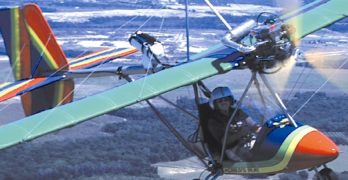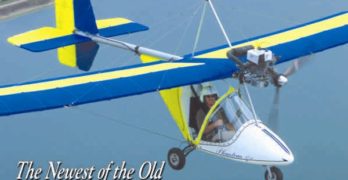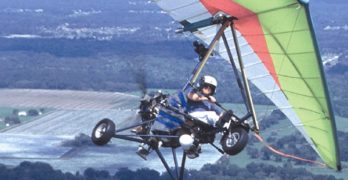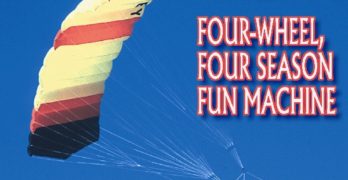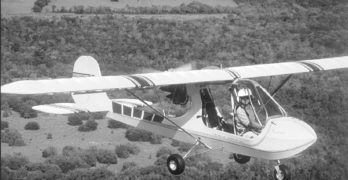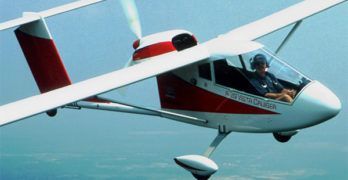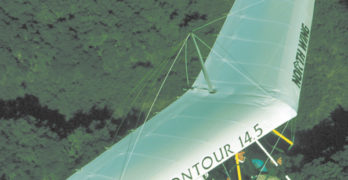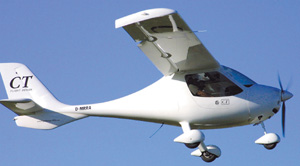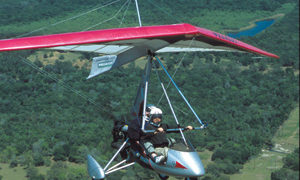Thousands of other Phantom ultralights are flying, but the one I was about to fly was built by a bunch of kids. Although they were no doubt serious and focused during the building effort, the Phantom X-1 was named Child’s Play. Had I lost my mind?
“So, you’re really going to fly that ultralight built by a bunch of elementary school kids, huh?” The question was more than small talk. The prospect actually worried some observers.
“Of course,” I replied. “The kids probably did a better job than I could.” I’m no builder, a fact I often repeat. After flying airplanes built by all kinds of pilots, I didn’t see the jeopardy in flying the product of students at the Haverhill Elementary School in Portage, Michigan.1
I admit I looked over the Phantom carefully, but I found no flaws. Besides, long-time Phantom pilot and Phantom Aircraft Company president Pat Schultheis had already test-flown it and put hours on it.
Search Results for : Ultralight April
Not finding exactly what you expected? Try our advanced search option.
Select a manufacturer to go straight to all our content about that manufacturer.
Select an aircraft model to go straight to all our content about that model.
Phantom X-1E
What would you do if you produced one of the best known and best loved classic ultralights in the world? If your name is Pat Schultheis and your brand is Phantom, you probably wouldn’t mess with success.
Known simply as Phantom to most folks, the proper name is actually the Phantom X-1. Even this model has gone through refinements over the years. And some builders have further varied the theme; one Phantom I flew had been converted to a taildragger – it was a blast.
A 2-seat Phantom model was tried years ago and newer efforts are underway at this time. The first effort, under the direction of then-Phantom company owner Jack Taylor, flopped so badly that after a short, challenging flight in the machine, I gave it back to the factory and told them I couldn’t report on it yet; it simply wasn’t right and shouldn’t be sold to customers.
Aerotrike
Until recently, we heard little from South Africa. Under the country’s apartheid (racial segregation) rule of the past, South Africa disappeared off the radar so far as most Yankee pilots knew. Our government instituted economic sanctions so that few, if any, South African products appeared in America.
Apartheid is over, and with it the isolation of that southern hemisphere country and its people. In recent years, we’ve seen a growing number of products arrive from the way down under country. Perhaps you’re not surprised to hear that South African ultralight builders are also making a mark on American aviation. Welcome to the modern age of globalization.
No Pushy Peddler
You probably already know of Rob Rollison. He garnered attention in April ’95 by flying his Air-Bike from Indiana to Lakeland, Florida.1 The trip set no records – Ian Coristine, Dave Goulet and Don Zank flew 2-seat Challengers 2,400 miles (round trip) from Moline, Illinois to Lakeland a decade earlier – but in an open-cockpit ultralight, no doubt Rob’s 870-mile (each way) flight seemed longer.
Para-Ski X-treme
Taking a broader view, this is similar to other forms of aviation. One only need look at airliners. From the outside, they’re virtually identical except in size, and for good reason. Airliner designers have discovered the optimal ways to build jets that accomplish their narrowly defined mission of speedy transportation.
On the light end, essentially the same can be said for trikes, or for that matter, for most types of ultralights. Fortunately, however, the purpose of fun aircraft remains widely varied, and that forces an interesting assortment of sport flying machines.
In this month’s Ultralight Flying! Pilot’s Report, we’ll look closely at the Para-Ski powered parachute. I believe you’ll agree it stands apart from the rest.
Versatility a Goal
Para-Ski International describes their machines as “the ultimate ATV/ASV (all terrain/all season vehicle).” It may sound like a big boast, but I think you’ll see Para-Ski may be able to honestly earn the title.
Hornet
Let’s cut right to the chase. Flying the Hornet for the second time in a couple of years (the second flight was in April ’96), I experienced a most disconcerting quality: flutter. While I have many good things to say about the Hornet, this one experience elbows its way to the front of the line. Easing into the “Pilot’s Report” on the Hornet simply isn’t possible when such an experience dominates my thinking.
Published in Light Sport and Ultralight Flying
Seating
2, tandem
Empty weight
475 pounds
Gross weight
1,000 pounds
Wingspan
27 feet 6 inches
Wing area
138 square feet
Wing loading
7.2 pounds/sq ft
Length
20 feet
Height
6 feet
Fuel Capacity
9 gallons
Kit type
Construction
Build time
250-400 hours
Standard engine
Hirth 2703
Power
55 horsepower
Power loading
18.2 pounds/hp
Cruise speed
100 mph
Never exceed speed
140 mph
Rate of climb at gross
500 fpm
Takeoff distance at gross
400 feet
Landing distance at gross
250 feet
Standard Features
Electric start, steerable nosewheel, pneumatic suspension on all wheels, hydraulic brakes, aluminum wheels, large tires, electric flaps, electric horizontal stabilizer trim, dual aileron control circuits, dual elevator control circuits, adjustable seats, disassembles for trailering; wings, fuselage and empennage factory-assembled.
Product Lines from May 2002
ST. PAUL, MINN. — My opening segment should start, “Once upon a time, there was Escape Pod, Pod Racer, and Porky Pod…” You’d probably be baffled (though perhaps intrigued). I’m referring to the Pod series from former Seagull hang glider boss, Mike Riggs. I’ve unabashedly promoted this project since it came from my challenge for a true “soaring trike.”
Pods are sleek fuselages to house pilots attached to hang glider wings. Their goal is to offer more comfort, low drag and light weight, and a rigid attachment to the glider. You fly seated/supine — and have a full enclosure. Think of a powered ultralight trike except one with all the draggy bits pulled inside. Escape Pod and Pod Racer (and surely Porky Pod, too, when it’s ready) will feature fully retractable tri-gear, in-flight C/G adjustment, and a molded clear plastic canopy that fits smoothly to a composite body. A positive aspect is the rigid connection to glider, such that you can never fall into the wing, possibly preventing broken gliders after a tumble or tuck.
Aeroprakt’s A-20 Vista Cruiser
UPDATE–November 2008: According to FPNA, an American company with a business relationship to A-20 producer Aeroprakt, the A-20 has been discontinued. Please contact FPNA for more information (contact info at end of article).
Two summers ago Americans saw a new aircraft from a Ukrainian company called Aeroprakt as U.S. importer Spectrum Aircraft brought in the A-22 Valor. It would be only the first in a fleet of new microlights.
Later another model from Aeroprakt appeared. In fact, the Vista series comprises 5 models, all variations on a basic theme that is nothing like the Valor. At present, the Ukraine enterprise has no less than nine models including the Valor, Vista, Cruiser, V-STOL, V-SS, Vulcan, Vulcan-SS, Victor single engine, Victor twin, and Viking. Four of this series are twin-engine aircraft, none are alike, and one is a 4-seater. By any measurement, this is quite an accomplishment from a company less than 10 years old and rising from the ashes of the failed Communist empire.
North Wing Design’s Loaded Apache
North Wing Design has a history that stretches back into the mid-1980s when 23-year-old owner Kamron Blevins started making hang glider wings. After gaining experience with other companies and dabbling with his own ideas along the way, Blevins started North Wing Design in 1996 to provide trike wings.
His timing was good. After years of work to encourage Americans to consider trikes, various suppliers – many from Europe – were pleased to see their efforts pay off. Trike numbers began to increase about the time North Wing Design got into business. At first, Blevin’s new company created specially built trike wings for several chassis suppliers and the enterprise grew.
With increasing sales of wings to others and with a rising tide of trike interest lifting all manufacturers, North Wing Design decided to go all the way. Their first full trike ultralight offering in 1999 was the Maverick, a slick single-seater that met FAR Part 103 parameters with a Rotax 447 (see “Pilot’s Report: North Wing Design’s Maverick Trike,” September 1999 Ultralight Flying!
Fixed -Wing or Flex-Wing
This month I wrote a pilot’s report about two widely different aircraft, both of which are imported by Rollison Airplane Company. Here’s how I handled it.
Every “Ultralight Flying! Pilot’s Report” has common elements: a main article, photos and photo legends, specifications, and our exclusive “Report Card.” Because the two subject flying machines are so different this month, I’ve prepared a “Report Card” for each aircraft. I did the same for specifications as the standard and optional features obviously differ too much for grouping.
In the main article, I take alternate looks at the two flying machines as a way to observe their differences, but further how they each have their benefits.
I also selected more photos – even though Ultralight Flying! reports regularly present many photos of ultralights being reviewed as readers often say that photos are a key informative element.
Because reviewing two different craft makes for a longer pilot report, I’ve somewhat abbreviated both the main article and the twin “Report Cards.”
Quite a few general aviation pilots recognize that ultralights offer a different way to fly| and that’s precisely what they like about them.
Flex-Wing or Fixed Wing
This month I wrote a pilot’s report about two widely different aircraft, both of which are imported by Rollison Airplane Company. Here’s how I handled it.
Every “Ultralight Flying! Pilot’s Report” has common elements: a main article, photos and photo legends, specifications, and our exclusive “Report Card.” Because the two subject flying machines are so different this month, I’ve prepared a “Report Card” for each aircraft. I did the same for specifications as the standard and optional features obviously differ too much for grouping.
In the main article, I take alternate looks at the two flying machines as a way to observe their differences, but further how they each have their benefits.
I also selected more photos – even though Ultralight Flying! reports regularly present many photos of ultralights being reviewed as readers often say that photos are a key informative element.
Because reviewing two different craft makes for a longer pilot report, I’ve somewhat abbreviated both the main article and the twin “Report Cards.”
Quite a few general aviation pilots recognize that ultralights offer a different way to fly| and that’s precisely what they like about them.


